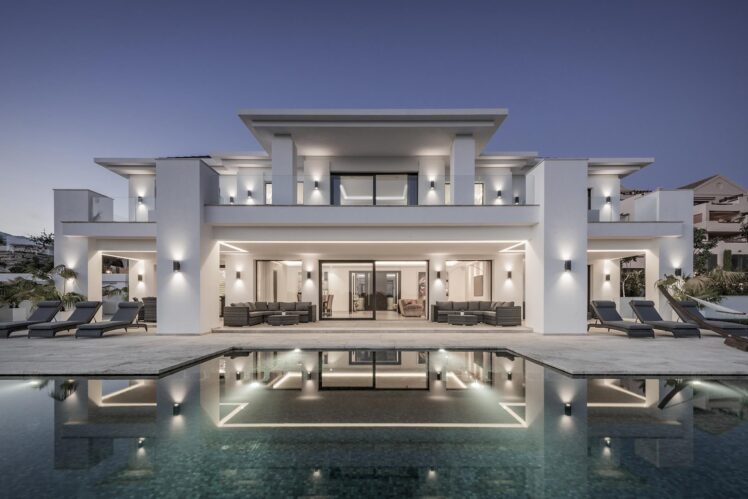Luxury properties typically have a lot to offer. You’ll have thousands of square feet of space, multiple rooms to show off, and views from windows that leave most people envious. If you were given hundreds of photos and paragraphs of description space to highlight everything worth showing about this property, you’d be able to fill it.
Of course, there’s a problem with this idea: you typically don’t have that space to work with. According to Wise Pelican, one of the most popular ways to market properties is via real estate postcards – and postcards don’t offer much space to show off the unique features of the property.
Similarly, online listing platforms typically restrict you in terms of how many photos you can upload and how much text you can include. Even if these physical limitations weren’t in place, you’d still have the short attention spans of prospective homebuyers to contend with.
So how are you supposed to showcase a full luxury property with such limited space?
Contents
Understand Your Audience

img source: discoverphds.com
Before you start thinking about how you’re going to market the property, think about the people to whom you’re going to market the property. Who are your target demographics? What are their values and perspectives? What is their education level? Are they married or single? A little bit of market research goes a long way here.
More importantly, what are the key challenges faced by these demographics? What are the key property features that this type of person is looking for? What are other properties simply not able to offer?
The better you understand your audience, the better you’ll be able to market to them, specifically. You don’t need 100 photographs to show if you can convince someone a property is worth touring in just 1.
Prepare the Basics

img source: res.cloudinary.com
You’ll need to dedicate at least some space to the “basics” of the property – the critical features that are going to be important for nearly all buyers. Fortunately, you won’t need much space for this, but you definitely don’t want to neglect it.
Leave space for:
- Location. Where is this property located? Depending on the context, listing a city may be plenty.
- Square footage. How big is this property?
- Bedrooms/bathrooms. How many of eac are there?
- Price or range. People need to know whether this is something they can afford.
- Year built/updated. When was this property constructed and/or when was it last majorly updated?
- Contact info. Depending on the platform or marketing channel you’re using, you may also need to dedicate some space for your contact information.
Consider the Unique Features of the Property

img source: criteriaforsuccess.com
In the marketing world, brands often need to consider their unique value proposition (UVP). In a given sector of the market, there are typically hundreds, thousands, or even millions of competing businesses, all of which can be described with the same generic description. So what would make someone choose one business over another in this space? The answer is their UVP – the unique qualities, features, or benefits of that business that no other business can match.
If you want to make the most of your limited marketing space, you need to figure out what your luxury property’s UVP is. In other words, what are the key characteristics that this property enjoys, but that other luxury properties in the area don’t have? Does it offer more space? Does it have an unmatched view of the ocean? Does it have a 6-car garage? Be ready to highlight the most important feature (or two) that define this property.
Start With Excess and Trim Down

img source: i.pinimg.com
Instead of wracking your brain to come up with the singularly most important photo or sentence to describe the property, work on providing as many photos and as much description as you’d like. Start with a rough draft where you’re free to include everything.
Once you have this, you’ll have the opportunity to review it. When going through your giant list of features, which ones seem to pop out at you? Which ones are most important? Which ones don’t seem as consequential? Gradually, you can identify the weak links in the chain and remove them.
When you’re done with this process, you’ll be left with only the best description lines and only the best photos – and you can work to combine them and fit them to any marketing medium you choose.
Experiment

img source: www.experiment
Depending on your approach, you may also have the opportunity to experiment. Instead of perfecting a single design and sending it out to the masses, try 3 or 4 different designs. From there, you’ll be able to:
- Measure your impact. To start, you’ll need to measure the outcome of your experiment as thoroughly as possible. If you’re placing digital advertisements, how many impressions are you getting? What is your click through rate? How many people ultimately convert? If you’re sending postcards, how many people are receiving those postcards and how many are using them to visit your website? Comparing these metrics between your “A” and “B” versions can help you figure out which variables are most important.
- Collect feedback. It’s also a good idea to collect feedback from your users directly. Use advanced tracking software to track user attention in your digital assets; otherwise, you can use surveys to see how people feel about your marketing materials. Is this luxury property not a good fit? If not, why? Is there anything that could persuade them? This qualitative information can be highly valuable.
- Make improvements. Finally, be willing to make adjustments and improve. Chances are, your first attempt will give you lackluster results – but sometimes, all it takes is a small change to your photos, copy, layout, or target audience to see much better impact.

img source: zricks.com
No matter what, this is going to be a time intensive and iterative process, so be prepared to make improvements to your original work. You’re not going to be an expert, perfectionistic luxury real estate marketer in your first foray, but if you’re patient and committed to improving, eventually you’ll see much better results.
